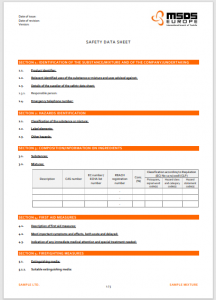Content and format elements of a safety data sheet
Safety data sheet knowledge base – Content and format elements of a safety data sheet (EU) 2020/878
A safety data sheet must provide information on the hazards as well as on the safe storage, handling and disposal of a substance or a mixture. The possession of this information shall enable users to take the necessary measures related to the protection of human health and safety at the workplace, and protection of the environment.
The content and format requirements of a safety data sheet are currently defined by Regulation (EU) 2020/878.
The regulation that came into force on 1 January, 2021 replaces Regulation (EU) No 2015/830 which contained the substantive and formal requirements of safety data sheets
After 1 January, 2023, the safety data sheet of every product available on the market should comply with this regulation, which means that every safety data sheet should be revised until 31 December, 2022
ES I CS I DE I EN I FR I IT I HU I PL I RO I SK I SL
Content and format elements of a safety data sheet according to Regulation 2020/878
SECTION 1: Identification of the substance/mixture and of the company/undertaking
1.1. Product identifier
Where a mixture has a unique formula identifier (UFI) in accordance with section 5 of Part A of Annex VIII to Regulation (EC) No 1272/2008 and that UFI is indicated in the safety data sheet, then the UFI shall be provided in this subsection.
1.2. Relevant identified uses of the substance or mixture and uses advised against
1.3. Details of the supplier of the safety data sheet
1.4. Emergency telephone number
SECTION 2: Hazards identification
2.1. Classification of the substance or mixture
2.2. Label elements
2.3. Other hazards
SECTION 3: Composition/information on ingredients
3.1. Substances
3.2. Mixtures
SECTION 4: First aid measures
4.1. Description of first aid measures
4.2. Most important symptoms and effects, both acute and delayed
4.3. Indication of any immediate medical attention and special treatment needed
SECTION 5: Firefighting measures
5.1. Extinguishing media
5.2. Special hazards arising from the substance or mixture
5.3. Advice for firefighters
SECTION 6: Accidental release measures
6.1. Personal precautions, protective equipment and emergency procedures
6.2. Environmental precautions
6.3. Methods and material for containment and cleaning up
6.4. Reference to other sections
SECTION 7: Handling and storage
7.1. Precautions for safe handling
7.2. Conditions for safe storage, including any incompatibilities
7.3. Specific end use(s)
SECTION 8: Exposure controls/personal protection
8.1. Control parameters
8.2. Exposure controls
SECTION 9: Physical and chemical properties
9.1. Information on basic physical and chemical properties
9.2. Other information
SECTION 10: Stability and reactivity
10.1. Reactivity
10.2. Chemical stability
10.3. Possibility of hazardous reactions
10.4. Conditions to avoid
10.5. Incompatible materials
10.6. Hazardous decomposition products
SECTION 11: Toxicological information
11.1. Information on hazard classes as defined in Regulation (EC) No 1272/2008
11.2. Information on other hazards
SECTION 12: Ecological information
12.1. Toxicity
12.2. Persistence and degradability
12.3. Bioaccumulative potential
12.4. Mobility in soil
12.5. Results of PBT and vPvB assessment
12.6. Endocrine disrupting properties
12.7. Other adverse effects
SECTION 13: Disposal considerations
13.1. Waste treatment methods
SECTION 14: Transport information
14.1. UN number or ID number
14.2. UN proper shipping name
14.3. Transport hazard class(es)
14.4. Packing group
14.5. Environmental hazards
14.6. Special precautions for user
14.7. Maritime transport in bulk according to IMO instruments
SECTION 15: Regulatory information
15.1. Safety, health and environmental regulations/legislation specific for the substance or mixture
15.2. Chemical safety assessment
SECTION 16: Other information
Other important information about content and format elements of a safety data sheet
The safety data sheet shall not contain blank subsections, it should be clearly stated, if specific data are not used or data is not available.
In addition, the compiler of the safety data sheet may also indicate other subsections, provided that they do not contain contradictory information to other sections of the safety data sheet.
A safety data sheet is not a fixed length document, but its length shall be commensurate with the hazard of the substance or mixture and the information available. The information must be formulated in a clear and concise manner.
The language used in the safety data sheet shall be simple, clear and precise, avoiding jargon, acronyms and abbreviations. Statements indicating that the substance or mixture is not hazardous (such as ‘may be dangerous’, ‘harmless’, ‘no health effects’) or any other statements that are inconsistent with the classification of that substance or mixture shall not be used.
All pages of a safety data sheet shall be numbered and shall bear either an indication of the length of the safety data sheet (such as ‘page 1 of 3’) or an indication whether there is a page following (such as ‘Continued on next page’ or ‘End of safety data sheet’).
The safety data sheet shall be prepared by a competent person who shall take into account the specific needs and knowledge of the user audience, as far as they are known. In some cases this may mean the work of more than one person, as the creation of a safety data sheet requires a wide range of knowledge.
The safety data sheet shall be delivered free of charge, on paper or in electronic form, at the latest at the time when the substance or mixture is first delivered.
The safety data sheet should be guaranteed in the official language(s) of the Member State(s) where the substance or mixture is placed on the market, unless the Member State(s) concerned provide(s) otherwise
Offered services
- Translation of safety data sheet
- Revision, update of safety data sheets
- Compilation, creation of a safety data sheet
- Compilation of label
Recommended article(s)
- Validity period of a safety data sheet
- Definition of safety data sheet
- Useful information for downstream users on safety data sheets
- Checking and implementing the exposure scenario


